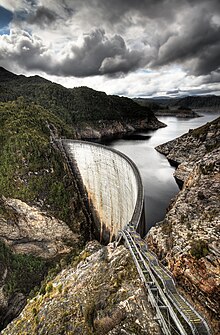Arch dam
An arch dam (Austrian vault dam ) is a type of the shut-off of a dam . It is basically made of concrete and is very slim compared to its height. In contrast to a gravity dam, an arch dam does not counteract the horizontal pressure of the water with its own weight, but instead directs the forces to the left and right into the two slopes by means of the arching effect .
construction
Arch dams are curved like an arch in plan and often also in cross-section and are supported on both sides on the valley flanks. In this way, the horizontal water load is carried into the subsoil. The foundation of an arch dam is called Pulvino . Arch dams are particularly suitable in narrow, steep valleys, so they are mainly found in the high mountains. The foundation must be on rock.
A common combination of the two types is the arched weight wall .
Arch dams are further divided into:
- Cylinder dams
- the radius and the "opening angle" are constant
- Equal radius dam walls
- the radius is constant and the angle is variable
- Equiangular dams
- the angle is constant and the radius is variable
- Dome dams (also called double arch dams)
- the modern shape common today: the radius and angle are variable, with curvature in the vertical and horizontal direction
In contrast to a gravity dam, the contact area is relatively small. Therefore, in addition to the valley flanks, the subsoil must also absorb a relatively high load. A stable bedrock is therefore required. An arch dam is suitable where very narrow valleys with great heights are to be blocked off. In broad mountain valleys, gravity dams or dams are more suitable. For these reasons, there is only one arch dam in Germany, the Ofenwald Dam , but there are more in Austria and Switzerland.
To prove the stability of an arch dam one can u. a. use the older test load method or the trial load method as well as the modern finite element method .
history
The Romans built one of the first arch dams in the Vallon de Baume south of Saint-Rémy in Provence, France. The dam of Glanum was 12 m high, 18 m long, 3.9 m thick and served to supply the nearby city with water. The radius was 14 m and the opening angle 73 °. It consisted of two walls with a panel in between. In 1891 a modern dam was built over it, there is only one drawing left.
The Eastern Roman historian Prokop describes an arch dam in Dara in his architectural treatise .
The dam built around 540/550 AD at the Iron Gate in Antioch on the Orontes , today Antakya , is probably the oldest arch dam on earth that is still partially preserved. The dam, a mixture of arch and gravity dam, was 17 m high and part of a city gate ("Iron Gate"), which was 32 m high.
The Mongols also built some arch dams , for example the Kurit Dam .
The François Zola Dam from 1854 is the world's first modern arch dam. Another of the oldest existing arched walls in Europe dams the water of Lac de Montsalvens in the canton of Friborg . It was completed in 1920.
Other outstanding arch dam structures of the 19th century are:
- Meer Allum, India, 1804
- Jones Falls, Canada, 1831
- Paramatta, Australia, 1856
- 75 Miles Dam, Australia, 1880
- Lithgow No. 1, Australia, 1896
Examples
- Cahora Bassa Dam (Mozambique)
- Enguri dam (Georgia, highest arch dam on earth)
- Kölnbreintalsperre of Maltakraftwerke (largest dam in Austria)
- Katse dam (Lesotho)
- Lac d'Emosson (Switzerland)
- Lago di Vogorno (Switzerland)
- Malpasset , Frejus (France, collapsed in 1959)
- Ofenwaldsperre (Germany)
- Vajont (Italy, disaster 1963)
literature
- JO Pedro: Arch Dams . International Center for Mechanical Sciences, Laboratório Nacional de Engenharia.
- Hubert Chanson, D. Patrick James: Historical Developments of Arch Dams: From Cut-stone Arches to Modern Concrete Designs. 2002, ISSN 0819-0259 1440-7027 ( online ).
Web links
Individual evidence
- ↑ a b Peter Rißler: dam practice . Oldenbourg Verlag, Munich 1999, pp. 90-92.
- ↑ Key Developments in the History of Arch Dams ( Memento of the original from April 15, 2009 in the Internet Archive ) Info: The archive link was inserted automatically and has not yet been checked. Please check the original and archive link according to the instructions and then remove this notice.
- ↑ Histoire des barrages
- ^ Mathias Döring: The Iron Gate, a 1500 year old arch dam in Antioch (Turkey). In: Messages from IWW Aachen. Issue 158, Dams in Transition, 15th German Dam Symposium 14. – 16. April 2010 Aachen.
- ↑ German Dam Committee e. V. (Ed.): Dams in Germany , Springer Vieweg-Verlag, 2013, page 166



